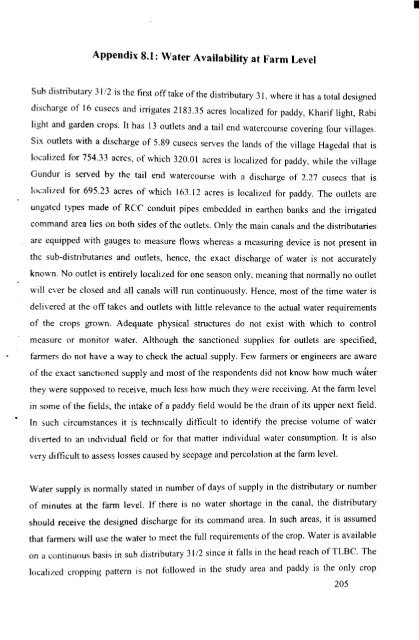Water Users Association and Irrigation Management - Institute for ...
Water Users Association and Irrigation Management - Institute for ...
Water Users Association and Irrigation Management - Institute for ...
Create successful ePaper yourself
Turn your PDF publications into a flip-book with our unique Google optimized e-Paper software.
•<br />
Appendix 8.1: <strong>Water</strong> Availability at Farm Level<br />
Sub distributary 3112 is the first off take of the distributary 31, where it has a total designed<br />
discharge of 16 cusecs <strong>and</strong> irrigates 2183.35 acres localized <strong>for</strong> paddy, Kharif light, Rabi<br />
light <strong>and</strong> garden crops. It has 13 outlets <strong>and</strong> a tail end watercourse covering four villages.<br />
Six outlets with a discharge of 5.89 cusecs serves the l<strong>and</strong>s of the village Hagedal that is<br />
localized <strong>for</strong> 754.33 acres, of which 320.0 I acres is localized <strong>for</strong> paddy, while the village<br />
Gundur is served by the tail end watercourse with a discharge of 2.27 cusecs that is<br />
localized <strong>for</strong> 695.23 acres of which 163.12 acres is localized <strong>for</strong> paddy. The outlets are<br />
ungated types made of RCC conduit pipes embedded in earthen banks <strong>and</strong> the irrigated<br />
comm<strong>and</strong> area lies on both sides of the outlets. Only the main canals <strong>and</strong> the distributaries<br />
are equipped with gauges to measure flows whereas a measuring device is not present in<br />
the sub-distrilrutaries <strong>and</strong> outlets, hence, the exact discharge of water is not accurately<br />
known. No outlet is entirely localized <strong>for</strong> one season only, meaning that normally no outlet<br />
will ever be closed <strong>and</strong> all canals will run continuously. Hence, most of the time water is<br />
delivered at the off takes <strong>and</strong> outlets with little relevance to the actual water requirements<br />
of the crops grown. Adequate physical structures do not exist with which to control<br />
measure or monitor water. Although the sanctioned supplies <strong>for</strong> outlets are specified,<br />
farmers do not have a way to check the actual supply. Few farmers or engineers are aware<br />
of the exact sanctioned supply <strong>and</strong> most of the respondents did not know how much water<br />
they were supposed to receive, much less how much they were receiving. At the farm level<br />
in some of the fields, the intake of a paddy fIeld would be the drain of its upper next field .<br />
•<br />
In such circumstances it is technically ditlicult to identify the precise volume of water<br />
diverted to an individual field or <strong>for</strong> that matter individual water consumption. It is also<br />
very ditlicult to assess losses caused by seepage <strong>and</strong> percolation at the farm level.<br />
<strong>Water</strong> supply is normally stated in number of days of supply in the distributary or number<br />
of minutes at the farm level. If there is no water shortage in the canal, the distributary<br />
should receive the designed discharge <strong>for</strong> its comm<strong>and</strong> area. In such areas, it is assumed<br />
that farmers will use the water to meet the full requirements of the crop. <strong>Water</strong> is available<br />
on a continuous basis in sub distributary 3112 since it falls in the head reach of TLBC. The<br />
localized cropping pattern is not followed in the study area <strong>and</strong> paddy is the only crop<br />
205
















